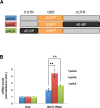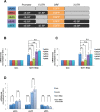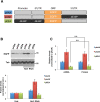Multi-functional regulation of 4E-BP gene expression by the Ccr4-Not complex
- PMID: 25793896
- PMCID: PMC4368434
- DOI: 10.1371/journal.pone.0113902
Multi-functional regulation of 4E-BP gene expression by the Ccr4-Not complex
Abstract
The mechanistic target of rapamycin (mTOR) signaling pathway is highly conserved from yeast to humans. It senses various environmental cues to regulate cellular growth and homeostasis. Deregulation of the pathway has been implicated in many pathological conditions including cancer. Phosphorylation cascades through the pathway have been extensively studied but not much is known about the regulation of gene expression of the pathway components. Here, we report that the mRNA level of eukaryotic translation initiation factor (eIF) subunit 4E-binding protein (4E-BP) gene, one of the key mTOR signaling components, is regulated by the highly conserved Ccr4-Not complex. RNAi knockdown of Not1, a putative scaffold protein of this protein complex, increases the mRNA level of 4E-BP in Drosophila Kc cells. Examination of the gene expression mechanism using reporter swap constructs reveals that Not1 depletion increases reporter mRNAs with the 3'UTR of 4E-BP gene, but decreases the ones with the 4E-BP promoter region, suggesting that Ccr4-Not complex regulates both degradation and transcription of 4E-BP mRNA. These results indicate that the Ccr4-Not complex controls expression of a single gene at multiple levels and adjusts the magnitude of the total effect. Thus, our study reveals a novel regulatory mechanism of a key component of the mTOR signaling pathway at the level of gene expression.
Conflict of interest statement
Figures






Similar articles
-
Drosophila melanogaster Thor and response to Candida albicans infection.Eukaryot Cell. 2007 Apr;6(4):658-63. doi: 10.1128/EC.00346-06. Epub 2007 Feb 2. Eukaryot Cell. 2007. PMID: 17277170 Free PMC article.
-
NOT10 and C2orf29/NOT11 form a conserved module of the CCR4-NOT complex that docks onto the NOT1 N-terminal domain.RNA Biol. 2013 Feb;10(2):228-44. doi: 10.4161/rna.23018. Epub 2013 Jan 9. RNA Biol. 2013. PMID: 23303381 Free PMC article.
-
Maternal mRNA deadenylation and decay by the piRNA pathway in the early Drosophila embryo.Nature. 2010 Oct 28;467(7319):1128-32. doi: 10.1038/nature09465. Epub 2010 Oct 17. Nature. 2010. PMID: 20953170 Free PMC article.
-
mRNA localization in metazoans: A structural perspective.RNA Biol. 2017 Nov 2;14(11):1473-1484. doi: 10.1080/15476286.2017.1338231. Epub 2017 Jul 31. RNA Biol. 2017. PMID: 28640665 Free PMC article. Review.
-
Localization and translation control of slam in Drosophila cellularization.Fly (Austin). 2018;12(3-4):191-198. doi: 10.1080/19336934.2018.1520574. Epub 2018 Sep 18. Fly (Austin). 2018. PMID: 30211628 Free PMC article. Review.
Cited by
-
FoxO suppresses endoplasmic reticulum stress to inhibit growth of Tsc1-deficient tissues under nutrient restriction.Elife. 2020 Jun 11;9:e53159. doi: 10.7554/eLife.53159. Elife. 2020. PMID: 32525804 Free PMC article.
-
The CCR4-NOT complex contributes to repression of Major Histocompatibility Complex class II transcription.Sci Rep. 2017 Jun 14;7(1):3547. doi: 10.1038/s41598-017-03708-7. Sci Rep. 2017. PMID: 28615693 Free PMC article.
-
mTOR regulates the expression of DNA damage response enzymes in long-lived Snell dwarf, GHRKO, and PAPPA-KO mice.Aging Cell. 2017 Feb;16(1):52-60. doi: 10.1111/acel.12525. Epub 2016 Sep 13. Aging Cell. 2017. PMID: 27618784 Free PMC article.
-
The Ccr4-Not complex regulates TORC1 signaling and mitochondrial metabolism by promoting vacuole V-ATPase activity.PLoS Genet. 2020 Oct 16;16(10):e1009046. doi: 10.1371/journal.pgen.1009046. eCollection 2020 Oct. PLoS Genet. 2020. PMID: 33064727 Free PMC article.
References
-
- Wullschleger S, Loewith R, Hall MN (2006) TOR signaling in growth and metabolism. Cell 124: 471–484. - PubMed
Publication types
MeSH terms
Substances
LinkOut - more resources
Full Text Sources
Other Literature Sources
Molecular Biology Databases
Miscellaneous

